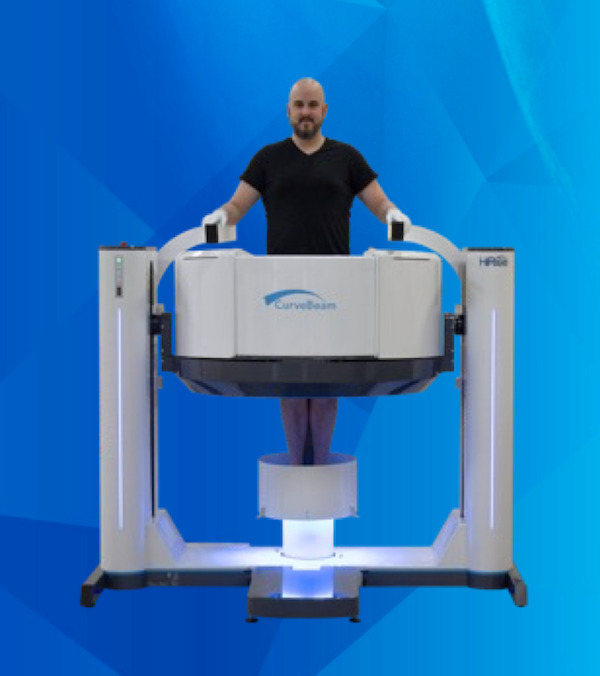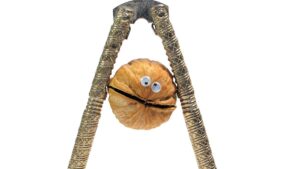Curvebeam’s “weight-bearing CT scanner” to gain more traction after FDA clearance

Curvebeam’s innovative products are revolutionising cone beam CT imaging. Pic: Getty Images
- Curvebeam’s innovative products are revolutionising cone beam CT imaging
- The company’s HiRise offers weight-bearing CT scans directly to a surgeon’s office
- The enhanced HiRise has recently received FDA clearance
The medical devices segment can offer appealing opportunities for investors.
Unlike pharmaceutical biotech companies, which face lengthy approval processes for new drugs, medical device biotechs have the potential to achieve a quicker path to market.
Curvebeam (ASX:CVB), a company in the medical imaging field, is one such player in the market.
Curvebeam is a leader in cone beam CT (computed tomography) imaging, setting new standards with its innovative products, HiRise and SkyRise.
HiRise is a pioneering device in weight-bearing CT scans that assess bone health for fragility risk from foot to hip.
Unlike traditional CT scanners that capture images while the patient is lying down, HiRise provides a dynamic view of bone and joint health while the patient is standing.
This unique approach allows for a more accurate assessment of joint conditions that might not be apparent when the patient is supine.
“A lot of people know they’ve got an issue, but it doesn’t come up on the CT scan when they’re lying down,” said Curvebeam CEO Greg Brown.
“But when they stand up, you can see exactly where the impingement is and the positioning of the bone, so doctors can see what’s going on in that joint.”
HiRise also delivers weight-bearing CT capabilities directly to a surgeon’s office, Brown explained.
“This means that not only can the imaging be conducted on-site, but it can also be reviewed immediately, providing critical insights into joint health.”

Brown says that when you take a weight-bearing CT scan, you can see exactly where the impingement is and how the bone is positioned.
“This leads to more accurate diagnoses and better surgical planning. For instance, the HiRise helps in identifying issues that may be missed by traditional scans, such as joint misalignments or arthritis.”
The HiRise has already gained significant traction since its FDA clearance in late 2020. It is currently being utilised extensively in the US and Europe, with 40 units installed to date.
In July, Curvebeam announced that an enhanced version of HiRise, the Enhanced HiRise scanner, has also received 510(k) clearance from the FDA.
The SkyRise also gaining traction
Curvebeam is also working on SkyRise, a device expected to launch in 2026.
SkyRise will extend the capabilities of HiRise to the upper body, including the spine and shoulders.
“Spine is by far the biggest anatomical issue, it’s around three-fold more prevalent than knee problems,” said Brown.
“SkyRise will feature a telescopic arm to accommodate a larger body size and will initially focus on CT imaging,” explained Brown.
“Future versions will include photon counting technology to provide detailed soft tissue imaging, enhancing the diagnostic capability for complex conditions affecting the shoulders and spine.”
Curvebeam AI’s products also utilise deep learning and artificial intelligence, which eliminates all the manual steps a doctor would have to otherwise take in order to give recommendations to patients.
Recent cap raise
Following the most recent FDA approval, Curvebeam has raised capital through an accelerated rights issue, securing a total of around $13.6 million.
“We are particularly focused on increasing our inventory to meet potential demand driven by our partnerships, such as with Stryker,” said Brown, referring to its New York-listed US distribution partner.
“The funds will also facilitate further validation of Curvebeam’s technology with robotic systems and support the company’s expansion efforts.
“We are targeting a $10 billion market with our innovative imaging solutions.
“With strong reimbursement support and strategic partnerships, Curvebeam is well-positioned to capitalise on this opportunity and deliver significant value to our investors.”
Other hot medical device stocks on the ASX
On the ASX, several medical device companies are capturing investors’ interest, including:
Established in 2003 in Silicon Valley, EBR has developed the WiSE Cardiac Resynchronization Therapy (CRT) system, the world’s first leadless pacing system for heart failure.
This innovative technology addresses ventricular dyssynchrony, where the heart’s right and left sides beat out of sync.
Unlike traditional methods that use external leads, the WiSE system is about the size of a grain of rice and uses wireless techniques to pace the left ventricle directly. The device comprises over 100 miniature components assembled by hand.
EBR recently shared positive results from its SOLVE-CRT trial at the Heart Rhythm Society conference in May 2023 and additional findings from a sub-study in September 2023.
These results have been published in JAMA Cardiology. The company is working on its pre-market approval submission to the FDA, with plans to complete the final module by Q3 2024 and target FDA approval by Q1 2025.
EMVision Medical Devices (ASX:EMV)
EMV focuses on creating innovative Radio Frequency (RF) sensing and imaging products designed to enable rapid diagnosis at the point-of-care.
The company develops portable RF devices, which aim to make high-quality imaging more accessible across various healthcare settings, including remote areas.
EMV’s flagship product is the “emu”, a portable, trolley-mounted device designed for use in intensive care units, stroke and neurology wards, and rural emergency departments.
It works by placing a simple cap on the patient’s head for quick scans and fast assessment of strokes.
The device uses safe, ultra-high frequency radio signals combined with advanced AI to provide immediate insights right at the patient’s bedside.
In July, EMV announced the completion of its First Responder (Gen 2) Proof of Concept device.
This device builds on the technology of the emu, but is lighter, more compact, and equipped with expanded antennas for comprehensive brain imaging in a single scan.
Imricor Medical Systems (ASX:IMR)
This disruptive medical device company has created the world’s only MRI-compatible devices for cardiac ablations, a procedure that uses a catheter to target and destroy cells causing arrhythmias.
Unlike X-ray fluoroscopy, which is good for visualising hard structures but struggles with soft tissues like the heart, MRI provides superior imaging to ensure precise ablation.
The company’s technology, covered by over 90 patents, is designed to work safely within MRI’s strong magnetic fields and offers a significant advancement in cardiac ablation.
Last week, IMR performed the first real-time MRI-guided cardiac ablation in the US at Johns Hopkins Hospital as part of its Vision-MR trial, supporting FDA approval. This trial is a follow-up to a successful European study showing 100% success at three months.
Vice President Nick Corkill noted that ventricular tachycardia (VT) is a severe condition with first-time success rates as low as 40% and lengthy procedure times.
Corkill also said that the cardiac ablation market, valued at over $10 billion annually, is rapidly growing.
The leader in POC (point of care) diagnostic technologies has developed the FebriDx rapid test to help doctors quickly and accurately differentiate a viral from bacterial acute respiratory infection.
FebriDx delivers results within 10 minutes from fingerstick blood, and can be used to help manage infectious patients in primary care, urgent care, emergency dept, paediatric and other outpatient settings.
“If it’s bacterial then obviously the illness will need antibiotics and if it’s viral then it may be more infectious and transmissible,” says LDX non-executive chairman, Sam Lanyon.
With antimicrobial resistance (AMR) considered by the World Health Organisation one of the top global public health and development threats, avoiding unnecessary use of antibiotics has become paramount, which is where LDX’s FebriDx is finding value.
“We are focused on the US because they have reimbursement,” Lanyon says.
“If there is a positive incentive for adoption such as the clinician or facility getting paid then they will use the product.”
BCal Diagnostics is developing a blood screening tool that is intended to be used alongside breast cancer screening methods.
BCal listed on the ASX in July 2021, having raised $10 million at 25 cents apiece.
Some of BCal’s intellectual property derives from Louisville University, which was replicating some of the scientific work.
BCal’s flasghip product, the Breastest, centres on lipids: fats that are a source of energy for cell growth.
“When the lipid metabolism is deregulated, this is the early sign of a cell becoming cancerous,” says BCal founder Jayne Shaw, a former nurse who co-founded the Sydney Breast Clinic.
The blood sample is drawn from the patient and then the extracellular vesicles (EVs) are enriched from the blood plasma that contain lipids. The blood is then matched against a panel of 18 biomarkers “characteristic of the presence of blood cancers”.
Flanked by pollies including Federal Health Minister Mark Butler, last May BXal opened its own lab in the Sydney suburb of North Ryde, equipped with advanced Liquid Chromatography Mass Spectrometry (LCMS) technology.
Mammograms might be the standard-of-care, but they are far from optimal. In Australia, 2.1 million mammograms took place in 2023, but a further 1.5 million eligible women did not get screened.
Thus, 41% of women eligible for a mammogram choose not to do so, often because the procedure is uncomfortable or for cultural reasons.
With Breastest, BCal claims a 90 per cent sensitivity and 85.5 per cent specificity.
Bcal is angling for US approval – initially as a laboratory test – which makes sense given the US accounts for 60% of the breast cancer diagnostics market.
At Stockhead we tell it like it is. While EBR Systems, Lumos Diagnostics, and Imricor Medical Systems are Stockhead advertisers, they did not sponsor this article.
Related Topics

SUBSCRIBE
Get the latest breaking news and stocks straight to your inbox.
It's free. Unsubscribe whenever you want.
By proceeding, you confirm you understand that we handle personal information in accordance with our Privacy Policy.








